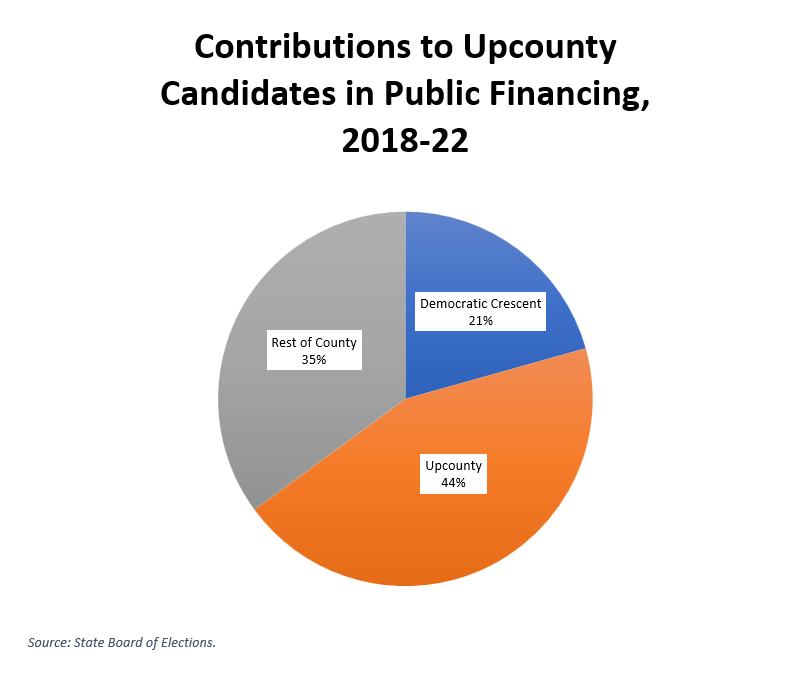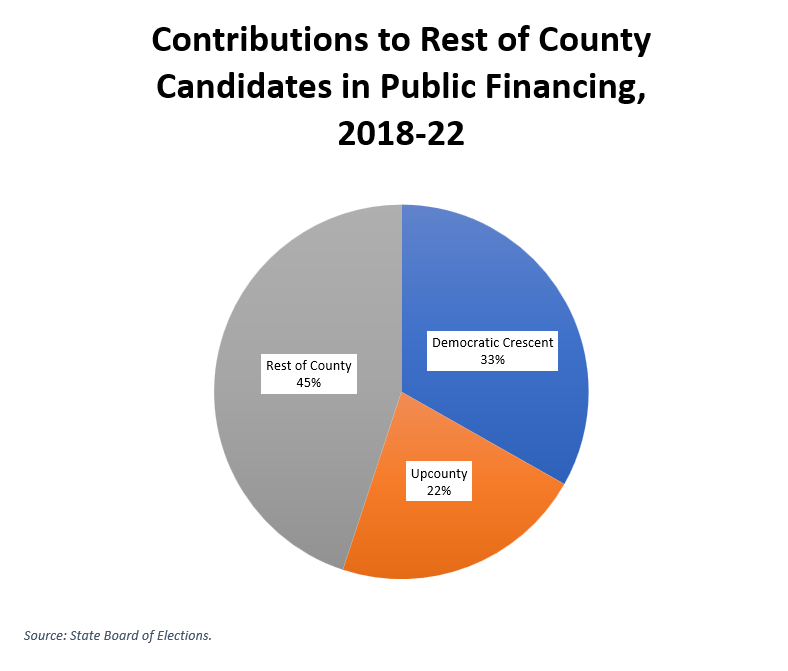By Adam Pagnucco.
In Part Four, we learned that Downcounty residents accounted for the majority of all contributions to publicly financed candidates, as well as candidates for county executive and council at-large. That’s not a big surprise as Downcounty’s turnout tends to be higher than elsewhere in the county. Now what about council district races?
One of the intentions of public financing was to move politicians away from interest groups and towards their own voters. District races have always featured more door-knocking than countywide races primarily because of logistics. In public financing, door knocks can turn into dollars because even small checks can be greatly magnified by public matching formulas. So one might believe that a district candidate’s contributors would be overwhelmingly from their own district.
But that’s not how it actually plays out.
We divided in-county individual contributions according to the three broad regions of the county: the Democratic Crescent (Downcounty), Upcounty and the rest of the county. (For definitions of these terms, see this post.) Then we divided council districts into those three regions as well. If fundraising matched residency, you would expect candidates from each region to get most of their money from that region. So for example, Upcounty candidates would have overwhelmingly Upcounty contributions. Let’s look at how well that holds up.
The Democratic Crescent
These are the areas in and around the Beltway that have long formed the core of county politics and activism. Candidates in the crescent using public financing have included:
District 1, 2018: Richard Banach, Bill Cook, Ana Sol Gutierrez, Jim McGee and Reggie Oldak. Andrew Friedson won this open seat race using traditional financing.
District 5, 2018: Kevin Harris and Kenge Malikidogo-Fludd. Incumbent Tom Hucker won this race using traditional financing.
District 4, 2022: Amy Ginsburg and Kate Stewart. Stewart, who was then the mayor of Takoma Park, won this open seat race.
Here are these candidates’ combined regions of in-county contributions.

Crescent contributors dominated these crescent races, but contributors from other regions did account for a quarter of these candidates’ take.
Upcounty
Generally speaking, these are areas north of Rockville and Leisure World, with the biggest population centers in Gaithersburg, Germantown, Montgomery Village, Clarksburg, Olney and Damascus. Candidates in Upcounty using public financing have included:
District 2, 2018: Ed Amatetti. Amatetti was a Republican who lost the general election to incumbent Craig Rice, who used traditional financing.
District 2, 2022: Marilyn Balcombe, Lorna Phillips Forde and William Roberts. Balcombe won this open seat race.
District 7, 2022: Andrew Einsmann, Paul Geller, Sharif Hidayat and Ben Wikner. Dawn Luedtke used traditional financing to win this race.
Here are these candidates’ combined regions of in-county contributions.

Less than half of these Upcounty candidates’ contributions came from Upcounty residents.
Rest of County
This is everything else. District 3 (Gaithersburg-Rockville) is split between Upcounty and rest of county, but since it goes quite aways down Rockville Pike, I assigned it here. Candidates in the rest of the county using public financing have included:
District 3, 2018: Sidney Katz. Katz was the incumbent and won reelection.
District 4, 2018: Nancy Navarro. Navarro was the incumbent and won reelection.
District 3, 2022: Rob Wu. Katz used traditional financing to win his third council race.
District 5, 2022: Brian Anleu, Fatmata Barrie and Kristin Mink. Mink won this open seat race.
District 6, 2022: Natali Fani-Gonzalez, Omar Lazo and Marice Morales. Fani-Gonzalez won this open seat race.
Here are these candidates’ combined regions of in-county contributions.

Once again, most of this money did not come from the same region. The Democratic Crescent accounted for a third of all contributions to these candidates even though the candidates mostly did not run there. (Mink was a council at-large candidate for part of the 2022 primary.)
What all of this demonstrates is that council district candidates raise a lot of money in public financing from people who do not live in their districts. And the above data omits contributions from people outside the county. So just how closely public financing ties candidates to their districts is a matter of debate. That said, one could still make the case that these candidates are more locally focused than those getting big PAC checks from Annapolis or D.C.
We will look at local areas next.
